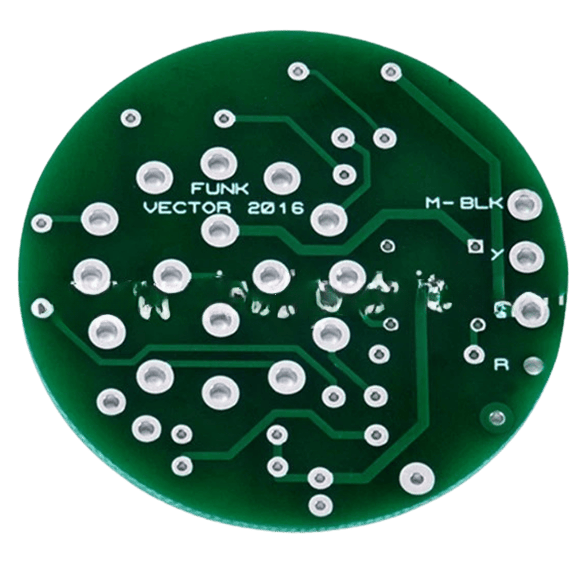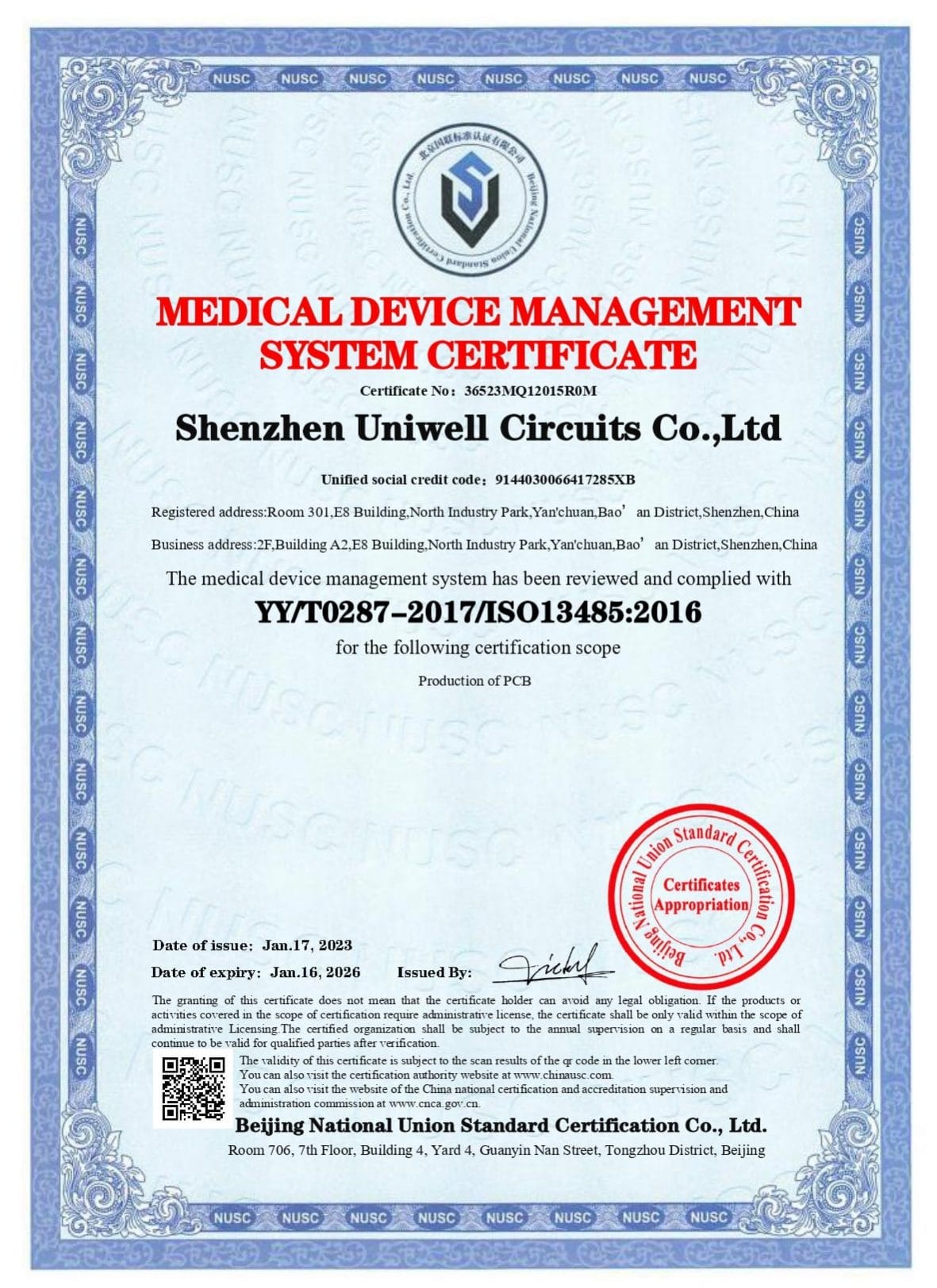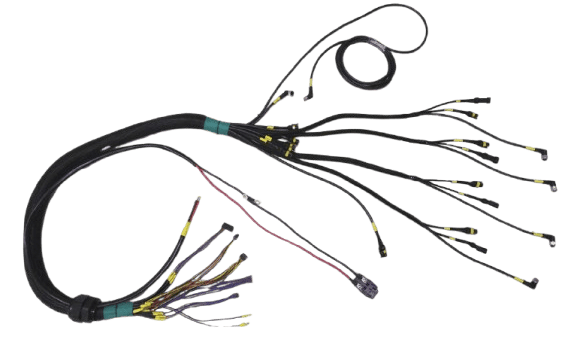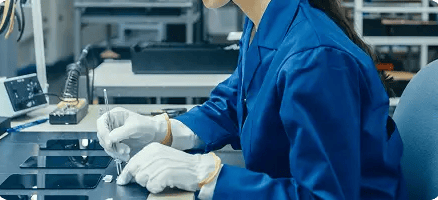Reliable Power Bank PCB
Assembly Solutions
WellPCB specializes in the design, fabrication, and assembly of high-performance power bank PCBs engineered for efficient voltage conversion, robust circuit protection, and seamless integration of fast charging protocols (PD, QC 3.0) across diverse configurations, including 5V, Type-C USB, and multi-cell 18650 battery packs.
- Advanced assembly including surface-mount (SMT), through-hole, and mixed technologies
- High-current handling with copper thickness up to 1000 μm
- Compliance with ISO 9001:2015, IPC-A-610H Class 3, and RoHS standards

ISO9001 ISO13485
ISO14001

IATF
16949

IPC-A-610H International
Certification

Fully Automated
AOI Inspection
- PCB Manufacturer
- PCB Assembly Service
- Power Bank
What is a Power Bank PCB?
A power bank PCB (printed circuit board) is the central platform for power storage, voltage conversion, and energy delivery in portable charging devices. It integrates control logic, power regulation, protection circuitry, and interface components, enabling safe and efficient charging and discharging cycles.
Key functions of a power bank circuit board include:
- •Voltage Step-Up Conversion: Boost converter circuits increase the lithium battery voltage (typically 3.7V nominal) to output levels such as 5V, 9V, 12V, or 20V, depending on the device’s requirements.
- •Current Regulation: Controls output currents commonly ranging from 1A and 2A up to high-power profiles (20W, 65W, 100W), including fast charging protocols (PD, QC 3.0, 20W fast charging).
- •Battery Management: Manages charging and discharging processes, often incorporating balancer circuits for multi-cell packs (like 18650 cells) to optimize cell health and longevity.
- •Protection Systems: Provides safeguards against overcharge, over-discharge, overcurrent, short-circuit, and thermal overload conditions.
- •Interface Support: Accommodates a variety of connectors, including dual USB, Type-C USB, micro USB, and legacy USB-A ports.
Modern power bank PCBs also support intelligent features such as load detection, LED display status indicators, and compatibility with emerging charging standards like USB-C, PD QC, and QC 3.0 for enhanced efficiency and user safety.

Our Manufacturing Capabilities
WellPCB delivers power bank PCB solutions using advanced fabrication methods, precision assembly processes, and comprehensive quality control to meet the demanding requirements of portable power applications. Our facilities support the complete production cycle, from prototype development to high-volume manufacturing.
We manufacture power bank circuit boards with layer counts ranging from 1 to 50 layers, supporting both single-layer economical designs and complex multilayer architectures for high-performance modules.
Our material options include FR-4, high Tg FR-4, halogen-free laminates, CEM-3, polyimide, and aluminum substrates. The availability of polyimide and aluminum materials allows us to support designs requiring exceptional thermal performance or mechanical flexibility, including fast charging and high-capacity power banks.
Copper thickness options up to 1000 μm enable the creation of boards capable of handling significant current loads, essential for high-wattage outputs such as 65W, 100W, and multi-port fast charging applications. Our fabrication process supports fine trace and spacing geometries down to 1.8 mil, allowing for compact, high-density designs that incorporate complex circuit protection and control features without sacrificing board size or efficiency.
Surface finishes include leaded HASL, lead-free HASL, Immersion Gold (ENIG), OSP, Immersion Silver, and Hard Gold, ensuring reliable conductivity and durability under repeated use cycles.
Our assembly lines support surface mount technology (SMT) and through-hole assembly (THT), with the flexibility to perform single-sided, double-sided, or mixed technology builds.
We utilize high-precision placement equipment capable of handling component sizes down to 0.2 mm for BGAs and 0.15 mm/0.25 mm for QFP packages, achieving placement accuracies within ±30 μm. Our SMT lines achieve speeds up to 60,000 chips per hour, allowing for efficient production of prototypes and large production runs.
Quality assurance is a central part of our production process. All power bank PCBs undergo automated optical inspection (AOI) and X-ray evaluation to verify solder joint integrity and component placement.
Electrical testing—including flying probe and impedance testing—is applied to confirm signal continuity, isolation, and controlled impedance where required. Reliability testing covers critical areas such as solderability, thermal shock resistance, and hole wall integrity, ensuring that every board meets industry performance expectations.
Our processes and quality standards comply with ISO 9001:2015, ISO 14001:2015, IPC-A-610H Class 3, and RoHS directives. We are also UL certified, supporting product safety and regulatory compliance in global markets.
We offer flexible production schedules, with standard lead times of 5 to 6 days and expedited services capable of delivering fully assembled boards in as little as 24 to 48 hours.
Our capacity ranges from single prototypes (as low as one piece) to high-volume manufacturing, providing scalability to match the needs of startups, established manufacturers, and custom product developers.
Our power bank PCBs integrate industry-standard ICs and advanced protection systems. Charging controllers like the TP4056 manage constant current/constant voltage (CC/CV) charging with automatic termination.
Protection ICs such as the DW01-P, often paired with dual MOSFETs (e.g., FS8205A), provide overcharge (4.25V ±50mV), over-discharge (2.4V ±0.1V), and overcurrent safeguards.
Boost converters such as the XL6009 regulate voltage for outputs up to 20V or higher. At the same time, system-on-chip solutions like the IP5358 and IP5328P enable smart energy distribution, multiple fast-charging protocols, and load balancing across multiple USB outputs.
Components of a Power Bank PCB
A power bank PCB integrates primary and supporting components that work together to manage power input, storage, regulation, and output while ensuring safety and efficiency.

Battery Management IC
Controls charging and discharging, manages overcharge, over-discharge, and balances charging for multi-cell packs.

Boost Converter
Steps up battery voltage to stable output levels (5V, 9V, 12V, 20V).

USB Connectors
Interfaces include dual USB, Type-C, USB-C, micro USB, and legacy USB-A for power input/output.

MOSFETs
Handles high-current switching and load control.

Capacitors
Stabilizes voltage supply and reduces output ripple

Inductors
Works with the boost converter to regulate current flow and minimize electromagnetic interference (EMI).

Resistors
Limits current and sets voltage levels for control and feedback circuits.

Protection Circuits
Prevents overcharge, over-discharge, overcurrent, short-circuit, and reverse polarity damage.

LEDs / Display
Provides visual feedback for charge status, output voltage, and error indicators (LED display, LEDs).

Thermal Sensors
Monitors temperature to trigger cooling or shutdown in case of thermal overload.
Why Choose WellPCB As Your Power
Bank PCB Fabrication Provider?

Certified Quality and
Process Control

Engineering Expertise in
Power Bank Circuit Design

Verified Material
Sourcing

Testing to Performance Standards

Fast Quoting and Responsive Production
Advanced Power Bank
PCB Technologies
Modern power bank PCBs incorporate advanced technologies to improve charging speed, device compatibility, and system efficiency. These innovations are essential for meeting the growing power demands of smartphones, tablets, laptops, and other portable electronics.


Cross-Section and X-ray Analysis
- •USB Power Delivery (PD): Dynamic voltage and current adjustments, enabling outputs like 5V, 9V, 12V, 15V, 20V, and up to 100W.
- •Qualcomm Quick Charge (QC 3.0) and QC 4.0: Allows rapid voltage stepping for efficient fast charging, reducing heat and charging time.
- •Support for proprietary protocols and dual compatibility (PD QC) where required.

Thermal Cycling and Thermal Shock Testing
Our power bank PCB designs also leverage the following integration technologies:
- •High-density PCB layout: Enables compact power bank module designs, reducing size without compromising performance.
- •Intelligent power management ICs: Dynamic current distribution, cell balancing (balancer circuits), and thermal regulation.
- •Smart load detection: Auto-adjusts output for connected devices, optimizing energy transfer.
- •Advanced circuit protection: Enhanced overcharge, over-discharge, overcurrent, and thermal protection with programmable thresholds.
- •Thermal management optimization: Use of high copper weights, thermal vias, and in some models, aluminum substrates for efficient heat dissipation.
Types of Power Bank PCB Comparison
| PCB Type | Max Current Handling | Thermal Performance | Size Efficiency | Cost Index | Fast Charging Support |
|---|---|---|---|---|---|
| Standard Power Bank PCB | Up to 2A | Moderate (FR-4, 1-2 oz copper) | High | Low | Basic (5V 1A/2A only) |
| Fast Charging PCB (PD/QC) | 3A – 5A (up to 100W) | High (FR-4 or Polyimide, 2-4 oz copper) | Medium | Moderate | PD, QC 3.0, QC 4.0, 20W to 100W |
| High-Capacity PCB | 5A+ | Very High (Polyimide or Aluminum, up to 5 oz copper) | Variable | High | PD QC, Smart Load Detection |
| Rugged/Industrial PCB | 3A – 10A | Very High (Aluminum or reinforced Polyimide) | Lower | Higher | Custom fast charging protocols |
Common Power Bank PCB Materials
Selecting the appropriate materials is critical to ensuring the power bank PCB delivers reliable performance, thermal stability, and durability, especially under varying current loads and operating environments.

FR-4
The most commonly used printed circuit board substrate, FR-4, offers a balance of mechanical strength, electrical insulation, and cost-efficiency.
Suitable for most standard power bank circuit designs, FR-4 handles moderate thermal loads and supports 5V, 2A, and fast charging applications up to 65W.

CEM-1
An economical alternative to FR-4, CEM-1 provides adequate performance for basic power bank modules requiring lower complexity and current capacity.
It’s often used in budget-friendly, single-layer power bank circuit boards.

Polyimide
Polyimide substrates offer superior thermal resistance, mechanical flexibility, and chemical stability.
Ideal for advanced or ruggedized power bank PCB designs that demand high temperature tolerance and flexible circuit integration, especially where fast charging generates additional heat.

Aluminum
Aluminum PCBs are used to prioritize heat dissipation and mechanical rigidity in power bank designs.
The metal core efficiently spreads heat away from power conversion components, improving the longevity and reliability of high-current power bank circuit boards, especially in fast charging models or dual USB 5V 2.4A outputs.
How to Order Your Power Bank PCB
in 5 Easy Steps
PCB Manufacturing and Order Review Process

Submit Your PCB Design
Upload your Gerber files or use our easy online PCB design tool to create your board layout. Make sure your files are complete and correctly formatted to ensure smooth processing and production accuracy.

Select Your PCB Specifications
Customize your order by choosing the technical specifications—number of layers, board dimensions, thickness, copper weight, solder mask color, surface finish, and more. Our intuitive interface helps you configure everything based on your project’s needs.

Get an Instant Quote
Once your design and specs are in place, you'll receive a transparent, instant quote. Pricing updates in real time as you modify options, so you can adjust your selections to match your budget before placing the order.

Confirm Order & Make Payment
Review your entire order for accuracy, including file previews and selected specs. After confirmation, proceed to secure checkout and choose your preferred payment method. You’ll receive an email confirmation with order details.

Production & Delivery
Your PCB moves into production immediately. We’ll keep you updated throughout the manufacturing process. Once completed, your boards are carefully packed and shipped to your door, with tracking information provided for your convenience.
Types of Power Bank Circuit Boards & Modules
Power bank PCBs are available in various configurations to meet diverse performance requirements, from basic portable chargers to advanced, high-capacity power bank modules. Each type is designed to balance output power, efficiency, form factor, and compatibility.

Standard Power Bank Circuit Board
These power bank circuit boards support single or dual USB output with common voltage profiles such as 5V 1A and 5V 2A.
They use FR-4 substrates designed for low to mid-capacity mobile power banks (e.g. 5000mAh to 10000mAh).

Fast Charging Power Bank Modules
Designed for higher performance, these modules support protocols like PD, QC 3.0, and proprietary fast charging standards.
Outputs include 20W fast charging, 45W, 65W, and even 100W for laptops and power-intensive devices. Interfaces often include USB-C, Type-C USB, and dual USB 5V 2.4A.

Power Bank Circuit Boards for 18650 Cells
These power bank PCBs are compatible with single or multi-cell 18650 battery packs, often including balancer circuits for charge equalization.
They offer flexible outputs (5V, 9V, 12V) and can incorporate circuit protection for overcharge, discharge, and thermal faults.

Custom and Advanced Module Boards
Advanced power bank modules feature integrated microcontrollers or smart ICs like IP5328P, enabling adaptive voltage outputs, optimized energy conversion, and additional functions such as LED display indicators, charging and discharging monitoring, and boost converter step-up power regulation.
These designs support DIY power bank projects and high-capacity configurations up to, 20000mAh or higher.
WellPCB is trusted by millions of
businesses and innovators.
























Why Choose WellPCB?
WellPCB stands out among USA PCB manufacturers by delivering superior quality, advanced solutions, and unmatched reliability. With years of experience serving global markets, WellPCB has earned a reputation as one of the top PCB manufacturers in USA.
WellPCB specializes in multilayer PCBs for advanced electronic applications. You can order these boards with $100 off using our special offer, providing high complexity at competitive rates for demanding projects.













Hommer Zhao
Founder and Chief Editor – Hommer Zhao
Welcome! I’m Hommer Zhao, the founder and Chief Editor of WellPCB. With years of experience in the PCB industry, I’m committed to making sure our content is both accurate and helpful. We’re proud to serve a growing community of over 4,000 customers worldwide, and our goal is to provide you with the best resources and support. Your satisfaction is our top priority, and we’re here to help you every step of the way!

Jesse Holland
Technical Manager – Jesse Holland
Hi, I’m Jesse Holland, an Engineer and Technical Manager at WellPCB. With years of experience in PCB design and engineering, I’m here to ensure that every project we work on meets the highest technical standards. I lead our team, focusing on precision and innovation, collaborating closely with clients to provide tailored solutions and expert guidance. Whether you’re facing a complex design challenge or need advice on technical aspects, I’m here to ensure your project is a success from start to finish.

Nathan Jensen
Purchasing Manager – Nathan Jensen
Hi, I’m Nathan Jenson, the Purchasing Manager at WellPCB. I’m responsible for sourcing the best materials and components to ensure our products meet the highest quality standards. With my extensive experience in procurement, I work closely with suppliers to secure reliable and cost-effective solutions while maintaining strong relationships to support our operations. I aim to ensure every project runs smoothly by providing the resources needed to deliver on time and to your satisfaction.

Emma
Sales Manager – Emma
Hey, I am Emma, sales manager at WellPCB. I studied electronic science and technology at university and have served customers for PCB and PCB Assembly service for several years.
I enjoy communicating with customers and our technicians to solve problems, and customers always say, "It's great to have you onboard".
It is my pleasure and honour to be helpful. Contact me now, and you'll know.

Bella and Cassiel
Sales Representatives – Bella and Cassiel
We’re Bella and Cassiel, your dedicated sales representatives at WellPCB. With our extensive knowledge of the PCB industry, we’re here to provide exceptional service and support. We take the time to understand your unique needs and are always ready to offer tailored solutions and advice. Whether you need product recommendations, assistance with your orders, or simply have a question, we’re here to ensure your experience is smooth and seamless at every step.

Mandy and Wendy
Sales Representatives – Mandy and Wendy
We’re Mandy and Wendy, your friendly sales representatives at WellPCB. Passionate about helping our customers, we bring a wealth of experience in the PCB industry to provide you with the best solutions and service. We take pride in building strong relationships with our clients, understanding their specific needs, and offering personalised support to ensure their satisfaction. Whether you’re looking for advice, product information, or assistance with any part of your order, we’re here to make your experience as smooth and efficient as possible.
Our Team
Our skilled engineers and technicians bring expertise and precision to every PCB assembly project. Committed to quality, efficiency, and innovation, our team ensures every order meets the highest UL, IPC, ROHS & REACH standards, delivering reliable solutions tailored to your needs.
- Founder and Chief Editor – Hommer Zhao
- Technical Manager – Jesse Holland
- Purchasing Manager – Nathan Jensen
- Sales Manager – Emma
- Sales Representatives – Bella and Cassiel
- Sales Representatives – Mandy and Wendy
Case Studies

PCB Specifications
- Layers: 8
- Board Thickness: 1.8mm
- Min. Line Width/Space: 3/3.5 mil
- Min. Hole Size: 0.2mm
- Min. Distance from Hole to Line: 0.13mm
- Inner Layer Copper: Hoz
- Outer Layer Copper: 1oz
- Surface Finish: Immersion Gold
The final board met all mechanical and electrical tolerances and passed electrical testing with 100% yield. This project shows our capabilities to handle complex, high-density multilayer PCBs with tight tolerances and strict quality standards.

Project Details
- Service Type: PCB Assembly
- Location: Italy
- Client Type: PCB Design Company
- Total Units: 20
- Lead Time: Rapid turnaround for prototyping
- Assembly Type: SMT+THT mixture assembly
Our experienced production team worked closely with the client to verify the BOM, optimize the stencil and the board’s layout design. We completed and delivered 20 fully assembled units within the expected lead time, allowing the client to avoid delays and meet their customers’ delivery window. This case highlights our capabilities to support global clients with flexible, low-volume PCB assembly solutions.

Project Details
- Service Type: Custom Automotive Wire Harness
- Location: New York, USA
- Client Type: Auto Repair Shop
- Quantity: 10,000 Units
Our team followed strict quality guidelines throughout production, using automotive-grade connectors and insulation materials. The order was completed on schedule with no reported defects, supporting the client’s rollout without interruption. This case shows our comprehensive capabilities in large-scale production, customized solutions, quality control and efficient delivery.
Power Bank PCB Service: Client Feedback
As an R&D manager, I have had an outstanding experience working with WELL-PCB. For many years, our company has entrusted them with the production, assembly, and programming of the boards developed in our R&D unit, and they have consistently exceeded our expectations.
Hamid Reza Moshayedi
R&D Manager
Their work is very impressively perfect. Today, when they check our company PCB board after assemble. They found a fake short point which many engineers has never found in the past years. But that is just designed so. The PCB board quality is excellent. Their service is also excellent.
MikeZ
My friend introduced WellPCB to me, the first try, a little look forward to. I ordered a 47*72 10ps PCB, and I can’t wait to receive my PCB. So I used expedited service and received my PCB in three days. I tested and soldered the PCB, Quality is really good, silkscreen, plating also great.
Warren Cliton
Power Bank PCB | FAQs
What safety requirements need to be considered in power bank PCB design?
Power bank PCBs must incorporate multiple safety features to manage electrical, thermal, and mechanical risks. This includes protection against overcharge, over-discharge, overcurrent, and short circuits. Designs must also prevent reverse polarity and manage thermal buildup. Compliance with recognized industry safety standards, such as UL, CE, and FCC, is necessary to confirm that the board can operate reliably across expected load conditions and environmental factors.
We use precision circuit protection ICs and discrete components to control voltage and current limits. Multi-cell designs often include balancer circuits to prevent uneven charging and discharging among cells, especially in configurations using 18650 cells or lithium battery packs.
How do you ensure effective heat management in your power bank PCBs?
Our power bank PCBs are engineered with several methods to control and distribute heat. We use high copper weights (up to 20 OZ) to reduce trace resistance and improve thermal conductivity. Where appropriate, thermal vias are added beneath heat-generating components to transfer heat to other PCB layers or external heat sinks.
For higher power applications, such as fast charging modules (20W, 45W, 65W, or 100W), we may incorporate aluminum substrates or use polyimide materials with better thermal tolerance. Our design team optimizes component placement to minimize hotspots, and our manufacturing process includes plasma-treated surfaces and heat spreaders for advanced cooling where required.
All designs are validated through thermal cycling and stress testing during the development and production phases to verify effective heat management under operating conditions.
Can you support custom power bank PCB designs with integrated displays and controls?
Yes. We can integrate LED display modules and microcontroller-based status indicators directly into the power bank PCB design. These features allow real-time battery voltage monitoring, current output, charge/discharge status, and temperature.
For designs requiring user controls, such as on/off switches or mode selection buttons, we can include appropriate circuitry and mechanical accommodations during the PCB layout phase.
What file formats are accepted for power bank PCB design submissions?
We accept multiple file formats to streamline the manufacturing process. Customers can submit Gerber files (RS-274X preferred) and .pcb, .pcbdoc, and .cam files. Our engineering team performs a full design rule check (DRC) on all submitted designs.
If any manufacturability or compliance issues are detected, we collaborate with customers to resolve them before proceeding to fabrication and assembly.
Work with WellPCB: Your Trusted Power Bank PCB Manufacturer
Get $100 Off Your First Order!
WellPCB offers end-to-end power bank PCB solutions combining advanced design, precision fabrication, fast charging integration, verified material sourcing, and certified quality control for prototypes and full production.





